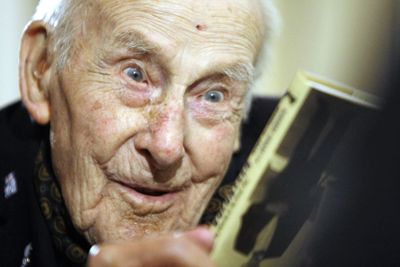In Passing

Henry Allingham, world’s oldest man
London – The world’s oldest man, 113-year-old World War I veteran Henry Allingham, died Saturday after spending his final years reminding Britain about the 9 million soldiers killed during the conflict.
Allingham was the last surviving original member of the Royal Air Force, which was formed in 1918. He made it a personal crusade to talk about a conflict that wiped out much of a generation.
“I want everyone to know,” he told the Associated Press during an interview in November. “They died for us.”
Only a handful of World War I veterans remain of the estimated 68 million mobilized. There are no French veterans left alive; the last living American-born veteran is Frank Woodruff Buckles of Charles Town, W.Va.
Kenneth Stampp, slavery historian
Oakland, Calif. – Kenneth M. Stampp, 96, a historian who helped transform the study of slavery in the United States by exposing plantation owners as practical businessmen, not romantics defending a noble heritage, died of heart ailments July 10 at a hospital in Oakland, Calif. He had vascular dementia.
His death was confirmed by the University of California at Berkeley, where he taught from 1946 until retiring in 1983.
Stampp denied having the burgeoning civil rights movement in mind when he researched and wrote “The Peculiar Institution” (1956), which powerfully challenged the way slavery was presented in history texts. But the impact of the book was undeniably linked to the changing era in which it appeared.
Leon Litwack, a Pulitzer Prize-winning historian who studied under Stampp and called him “one of the most important historians” of his generation, said that as late as the 1940s, many eminent historians of the South depicted slavery as a largely benign system.
Stampp was among the first mainstream writers to devastate that comforting “magnolia-blossom interpretation of the plantation,” Litwack said.
Julius Shulman, photographer
Los Angeles – Photographer Julius Shulman, who turned photos of Modernist buildings into works of art, has died, colleagues said Thursday. He was 98.
Shulman died Wednesday night at his home in the Hollywood Hills and had been in declining health, said gallery owner Craig Krull, who represented him.
“He, in my opinion and the opinions of many, is the most important architectural photographer in history. He elevated what you might consider a commercial genre to a fine art,” Krull said.
His most famous work was a black-and-white photo taken of a glass and steel frame home built by architect Pierre Koenig in the Hollywood Hills above Laurel Canyon Boulevard as the sun was setting on May 9, 1960. The picture from outside the cantilevered house was shot through its glass walls toward a sea of sparkling city lights below.